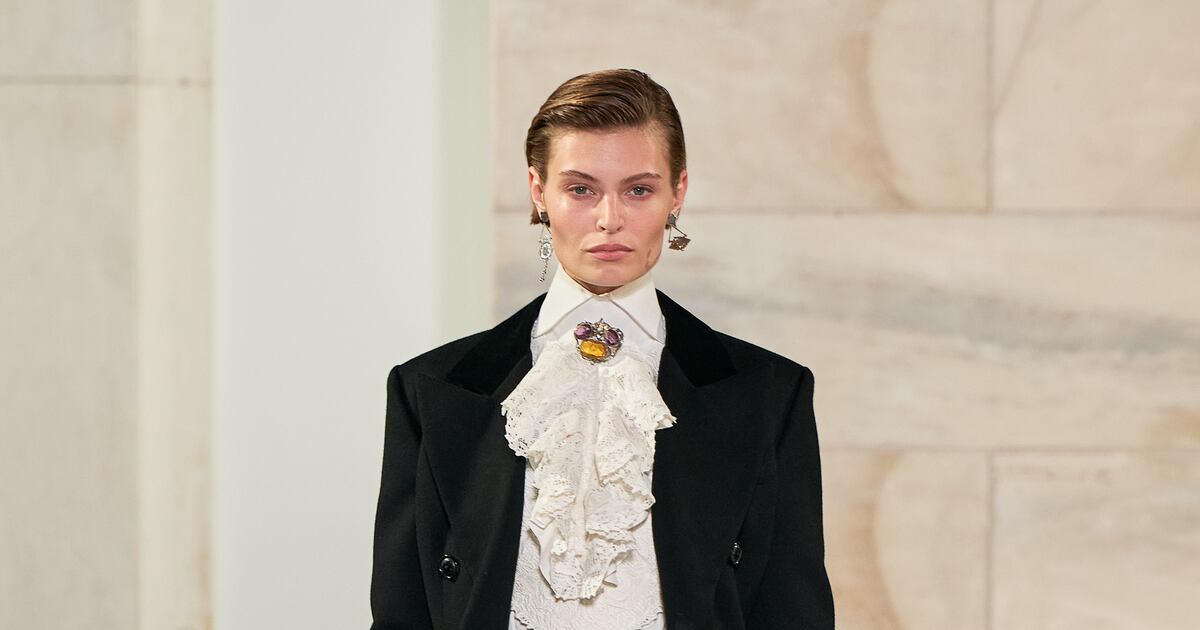Trend watchers lately are abuzz about âboom boom,â a fun, if loosely defined way to describe a last spasm of gaudy, â80s-style consumption before Trumpâs tariffs or a recession prematurely ends the party.
The change in mood presents something of a challenge for Ralph Lauren: If it takes hold beyond trend pieces and Instagram, boom boom threatens to sweep away the more timeless, âold moneyâ aesthetic that has hugely benefitted the brand in recent years.
The brandâs autumn 2025 show on Thursday offered a reminder that Ralph Lauren was pretty popular in the original boom boom era too. Held in a Beaux-Arts bank turned art gallery in Tribeca, the collection drew liberally from the early 1980s. The callbacks were often direct, such as a sequinned jumper nearly identical to one worn by Kristin âClotildeâ Holby in a 1982 campaign, and the lace jabots worn by many of the models, also seen in Ralph Lauren images of that era. Belted coats, ruffled dresses and leather boiler suits in blacks, browns and greys evoked the new romantics, while the occasional purple velvet dress nodded to â80s excess.
Riding the latest vibe shift is a multi-billion-dollar prerogative for Ralph Lauren. The brand has spent the last half decade-plus laser-focussed on two goals: First, elevation â Ralph Lauren as a luxury brand that sells cashmere coats and dresses Selena Gomez for the Oscars. And also, diversification â no matter your income or location, thereâs something you can buy, even if itâs just a cup of Ralphâs coffee.
Ralph Lauren had the good timing to implement the bulk of this strategy during the post-pandemic boom years, when consumers were ready to splurge on fashion, and Gen-Zers coming into their spending power began obsessing over the preppy aesthetic that the designer has been selling for nearly 60 years.
Shortly after the brand staged a blowout show in the Hamptons last September, complete with a one-night-only recreation of the Polo Bar, the companyâs stock hit an all-time high, then rocketed up another 60 percent by February. Sales in the last three months of 2024 rose 11 percent to $2.1 billion.
The way forward doesnât look so easy.
In the US, Ralph Laurenâs biggest market (North America makes up 44 percent of sales), consumer confidence has plunged to multi-year lows, and Goldman Sachs puts the odds of a recession in the next 12 months at 45 percent. Apparel and accessories spending fell 3.9 percent between the start of the year and late March, the steepest decline of any category, according to credit card data analysed by Earnest Research.
In China, where Ralph Laurenâs sales shot up more than 20 percent in the fourth quarter, and 8 percent of the overall business, thereâs the potential for trouble too.
Ralph Laurenâs last show before Thursdayâs was a âre-seeâ of the Hamptons collection in Shanghai. Heavy on blue blazers and cable knit sweaters, it was a testament to the classic Americana aesthetic that has caught fire in China and quickly turned the country into one of the brandâs biggest and fastest growing markets.
The show, Ralph Laurenâs first in the country, had the misfortune to take place on April 2, the same day President Donald Trump announced the steepest tariffs on imports in a century, with China emerging as the top target. China has retaliated with tariffs of its own. Rhetoric on both sides is heated. Experts say boycotts by Chinese consumers of brands closely identified with America â a regular event during past disputes over forced labour allegations in Xinjiang â are a possibility if relations continue to worsen.
Ralph Lauren chief executive Patrice Louvet says itâs moments like this when diversification matters.
âWe have momentum right now, the responsibility is on us to continue to fuel it, to continue to make sure weâre telling stories that are engaging and exciting,â Louvet said. âMaybe the absolute growth rate of the cycle is slower, but ⦠the market is very fragmented, thereâs still a lot of market share to be had.â
He spoke to a newfound âagilityâ that means the brand doesnât need to rely on a single category, customer or country. That goes for sales, but also applies to the supply chain, which has decreased its reliance on China from one-third of goods sold by dollar value pre-pandemic, to mid-single digits today.
Investors arenât totally convinced. Like most fashion companies, Ralph Lauren shares have regained only a portion of the steep losses they saw after Trumpâs April 2 tariff announcement.
If Ralph Lauren is going to come out ahead in a difficult period, itâll be on the strength of its brand. That goes for tariffs as well; either Ralph Lauren has to pay them, or it has to find someone else to do so. In most cases, thatâs the consumer, whoâs already shown a willingness to move upmarket with the brand: The average price of goods sold is up over 70 percent since 2018.
âThe absolute best way to offset both the impacts of a tariff and a potential recession is pricing power â if you have it,â said Simeon Siegel, an analyst at BMO Capital Markets.
A fashion show canât pull an economy away from the brink of recession or bring an end to a trade war, of course. But looked at another way, the â80s iconography of Thursdayâs show sent a reassuring message: In 1982, Americans were also worried about inflation, an economic downturn and worsening relations with its chief geopolitical rival, the Soviet Union. The country survived, and so did Ralph Lauren.
âThis companyâs been around for 58 years ⦠and weâve gone through many geopolitical and economic situations and all in all, done quite well throughout this entire time,â Louvet said. âIt gives us a lot of confidence moving forward.â

